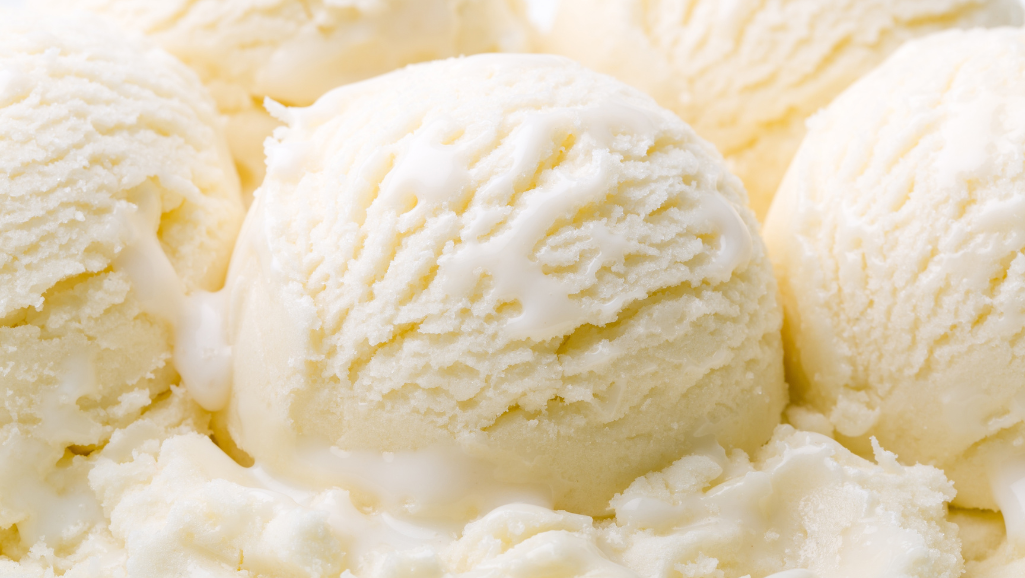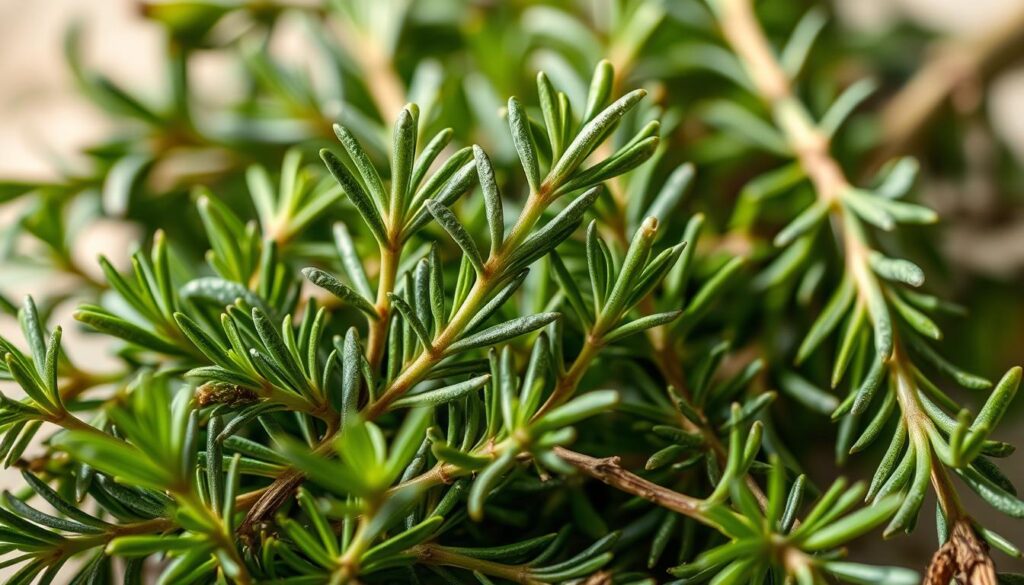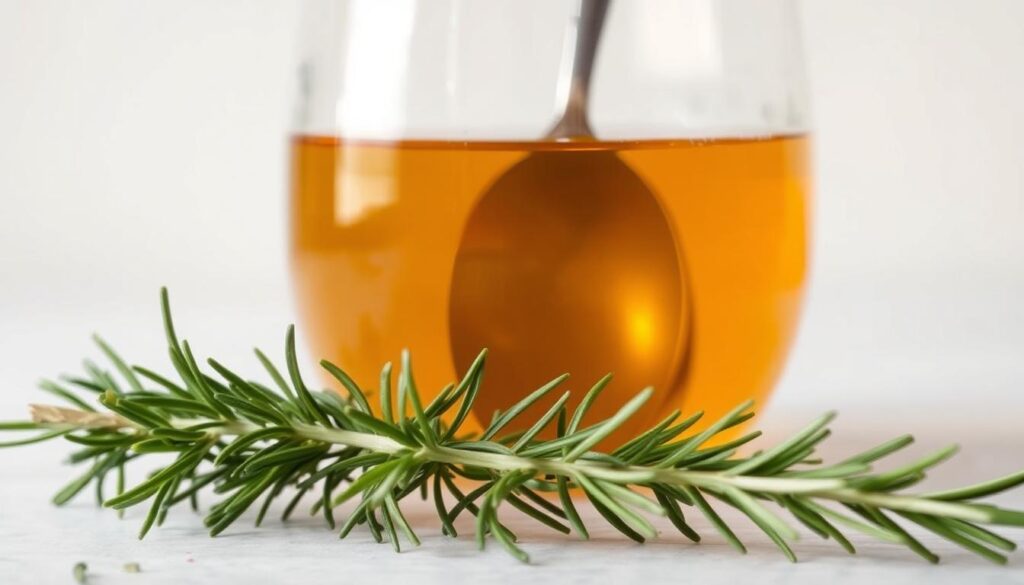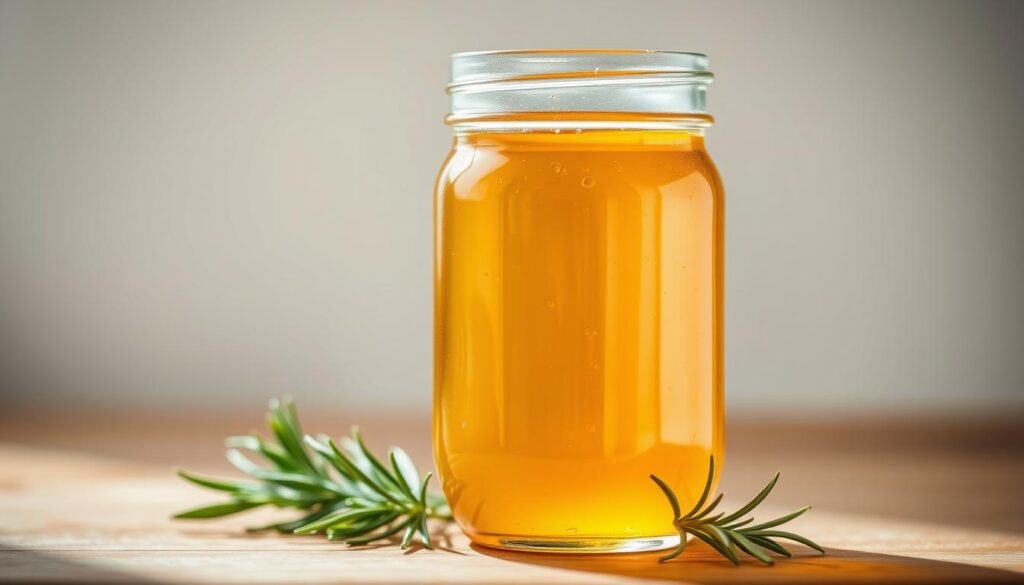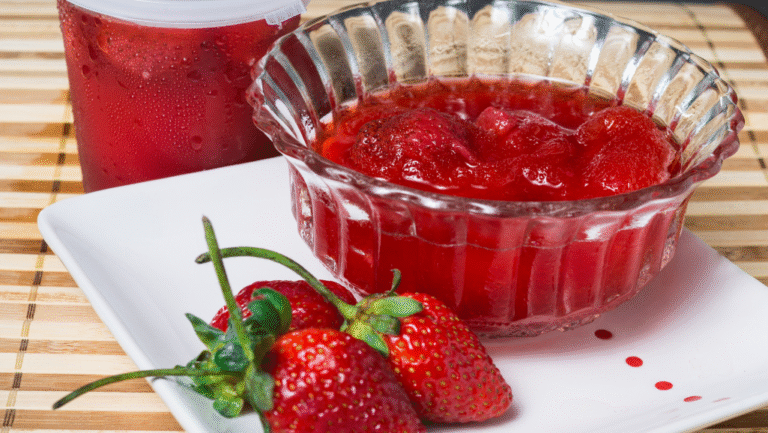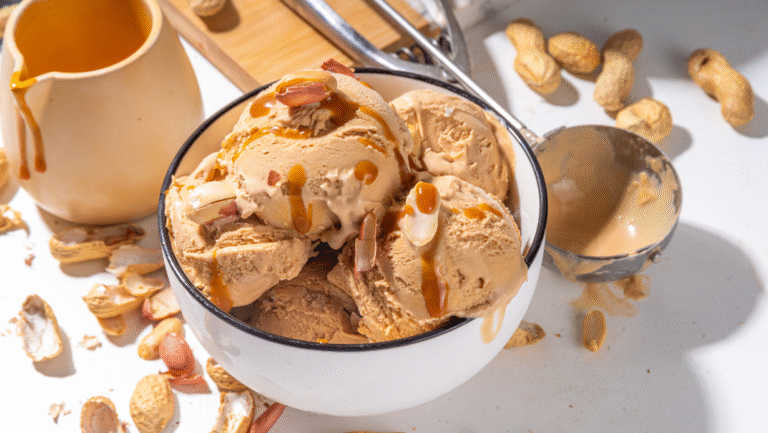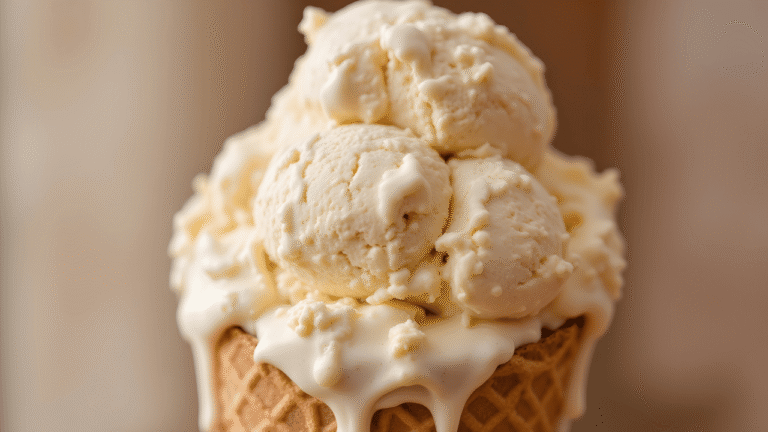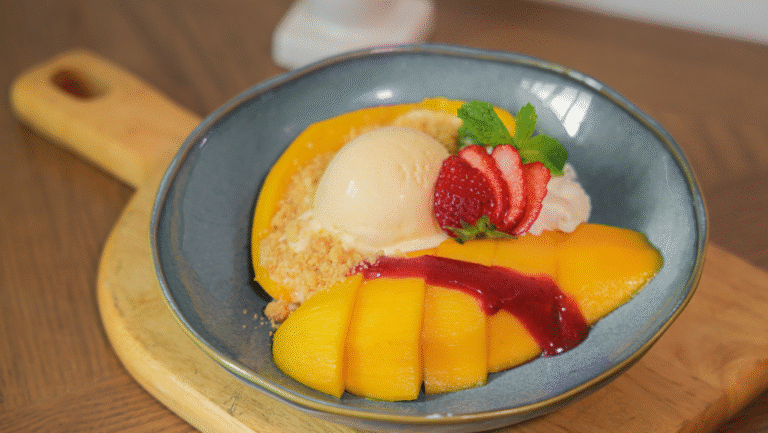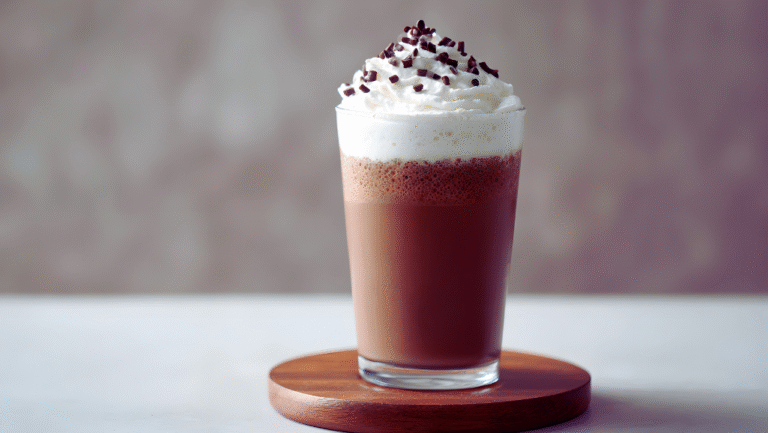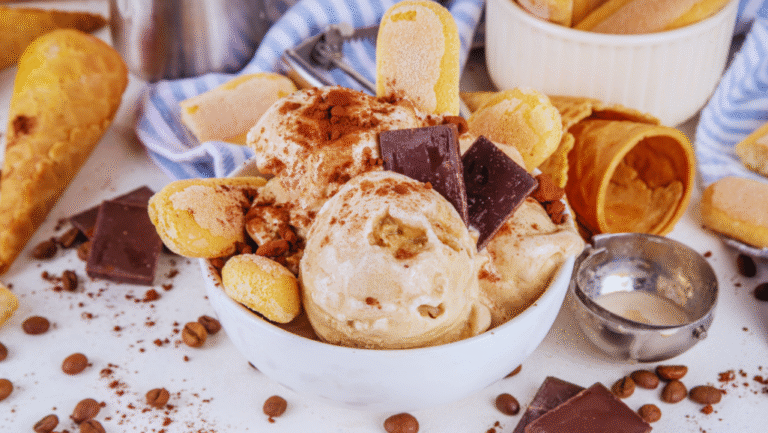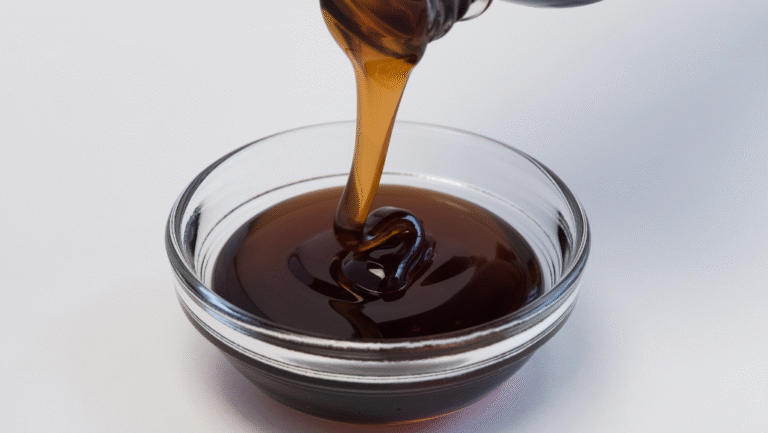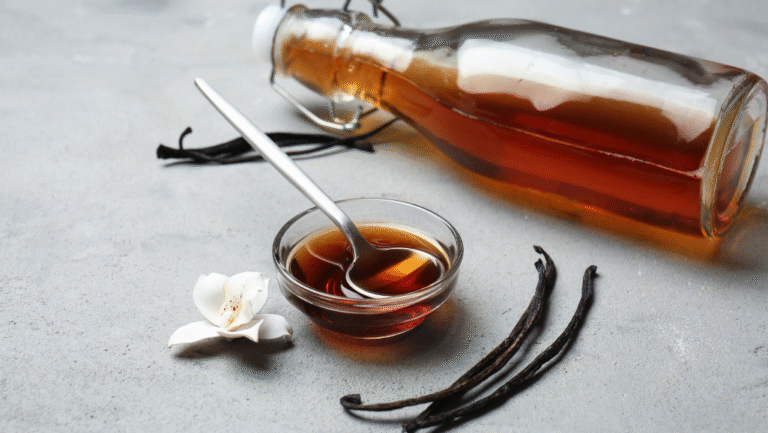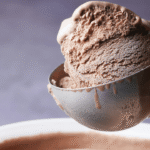Welcome. This approachable guide turns a basic liquid sweetener into an aromatic, herb-forward staple that lifts cocktails and cold drinks with little effort.
You will learn what a classic 1:1 sugar-to-water syrup is, why a richer 2:1 batch matters, and how an herb infusion adds depth without preservatives. Homemade batches taste clearer and cost less than store-bought versions.
No special tools are needed—just a saucepan, sieve, and a jar. A typical 1-cup sugar plus 1-cup water batch yields about 12 ounces, enough for many drinks, a glaze on cakes, or a drizzle over fruit.
Beginner-friendly and impressive: the method helps your home bar make silky cold cocktails where granulated sugar can stay grainy. It adds calories but contains no fat, so you can measure by the ounce for control.
Try it, then leave a comment sharing favorite pairings or twists for brunch, gifts, or weekend entertaining.
Key Takeaways
- rosemary simple syrup recipe.
- Infusing an herb turns basic syrup into a versatile flavor booster for drinks and desserts.
- Classic ratio 1:1; richer 2:1 for more body and longer shelf life.
- A standard batch yields about 12 ounces—enough for several cocktails or toppings.
- Homemade delivers cleaner taste, no preservatives, and adjustable intensity.
- Use a half to one ounce per drink for balanced sweetness; it adds calories but no fat.
- Only simple tools required: saucepan, sieve, and jar—great for beginners and hosts.
Why this rosemary simple syrup belongs in your kitchen today
In under half an hour you can make a small-batch flavor booster that lifts cocktails and cakes. Three ingredients—sugar, water, and fresh rosemary—turn into a fragrant infusion with very little effort.
Steep times are flexible: 15 minutes for a light herb note, up to 60 for a bold profile. That control means you can tailor the taste to a gin gimlet, a minty mule, or a citrus pound cake.
Homemade versions taste brighter than store options and cost less. Make a jar ahead of a party to speed service and keep your bar or kitchen running smoothly.
Elevate cocktails, mocktails, and even baking
Use a small splash to turn iced tea, lemonade, or cold coffee into grown-up drinks. It also brushes cake layers to add moisture and subtle herb notes that pair well with citrus or berries.
Three ingredients, minutes of effort, big flavor
- Fast payoff: Ready in under 30 minutes, with steeping time set by you.
- Versatile: Great in cocktails, non-alcoholic drinks, and baking.
- Waste-smart: Revive leftover sprigs and save money over bottled products.
Want more ideas? Try this full guide for technique and cocktails: rosemary simple syrup guide.
Creamy Vanilla Ice Cream
4
servings30
minutes40
minutes300
kcal1
hour10
minutesA simple homemade vanilla ice cream recipe with everyday ingredients.
Keep the screen of your device on
Ingredients
2 cups 2 heavy cream
1 cup 1 whole milk
3/4 cup 3/4 granulated sugar
1 tablespoon 1 pure vanilla extract
1/8 teaspoon 1/8 salt
Directions
- In a medium mixing bowl, whisk together the heavy cream, whole milk, granulated sugar, pure vanilla extract, and salt until the sugar is completely dissolved.
- Cover the bowl with plastic wrap and refrigerate the mixture for at least 2 hours, or until thoroughly chilled.
- Once chilled, pour the ice cream mixture into your ice cream maker and churn according to the manufacturer's instructions, typically 20-25 minutes.
- After churning, transfer the ice cream to an airtight container. Cover the surface with plastic wrap and seal the container tightly.
- Freeze the ice cream for an additional 2 hours to firm up before serving for the best texture.
Recipe Video
Nutrition Facts
- Serving Size: 0g
- Total number of serves: 8
- Calories: 260kcal
- Fat: 18g
- Saturated Fat: 11g
- Trans Fat: 0.5g
- Polyunsaturated Fat: 0.5g
- Monounsaturated Fat: 5g
- Cholesterol: 70mg
- Sodium: 40mg
- Potassium: 100mg
- Carbohydrates: 21g
- Fiber: 0g
- Sugar: 21g
- Protein: 2g
- Vitamin A: 15IU
- Vitamin C: 0mg
- Calcium: 6mg
- Iron: 0mg
- Vitamin D: 0mg
- Vitamin E: 0mg
- Vitamin K: 1mg
- Thiamin: 0mg
- Riboflavin: 0mg
- Niacin: 0mg
- Vitamin B6: 0mg
- Vitamin B12: 0mg
- Folate: 0mg
- Biotin: 0mg
- Pantothenic Acid: 0mg
- Phosphorus: 0mg
- Iodine: 0mg
- Magnesium: 0mg
- Zinc: 0mg
- Selenium: 0mg
- Copper: 0mg
- Manganese: 0mg
- Chromium: 0mg
- Molybdenum: 0mg
- Chloride: 0mg
Did you make this recipe?
Tag @https://www.instagram.com/ice_cream_haven/ on Instagram and hashtag it with #IceCreamIceCreamHavens
Like this recipe?
Follow @https://www.pinterest.com/Ice_Cream_Haven/ on Pinterest
Join our Facebook Group!
Follow https://www.facebook.com/icecreamhavens/ on Facebook
What is simple syrup and how rosemary transforms it
At its core, this classic liquid sweetener is just sugar dissolved in water, yet that clarity is what makes it so useful in cold and hot drinks.
Granulated sugar can stay grainy in iced beverages, while a syrup integrates instantly for smooth texture and consistent sweetness.
Use a 1:1 water-to-sugar ratio for everyday mixing. Choose a richer 2:1 batch when you want thicker body, longer shelf life, and bolder sweetness.
Infusing fresh rosemary adds an earthy, piney note that lifts spritzes, sours, and spirit-forward cocktails. Steep for about 15 minutes for a hint, or extend up to 60 minutes for a stronger botanical hit.
- Clean inputs: filtered water and white or cane sugar improve clarity.
- Measure: start with ½–1 ounce per drink and adjust to acidity or bitterness.
- Beyond drinks: brush on cake layers to add moisture and subtle herb flavor.
“A few active minutes on the stove, then a hands-off steep — that’s the easy way to add layered flavor to your bar and pantry.”
rosemary simple syrup recipe
Ready in minutes, this herb-infused sweetener turns pantry staples into bar-grade flavor.
Time, yield, and core ratio at a glance
Plan a few minutes of heating plus 15–60 minutes of steeping. Combine 1 cup sugar and 1 cup water with 4–5 fresh rosemary sprigs in a saucepan. Heat over medium, stirring until the sugar fully dissolves, then remove from heat and steep.
Classic vs. rich: choosing your sweetness
The classic 1:1 water-to-sugar ratio makes the most versatile simple syrup for cocktails and mocktails. It yields about 1½ cups—enough for a dozen drinks when you use ½–1 ounce per serving.
- Richer option: use a 2:1 sugar-to-water ratio for thicker body and less dilution in shaken drinks.
- Steep time: 15 minutes for a light herb note; up to 60 minutes for a bold profile—log the minutes so you can repeat your favorite intensity.
- Finish: strain through a fine-mesh sieve for a clear, attractive pour in glassware.
“Keep a consistent cup-to-cup approach to make repeatable batches that match your bar and pantry needs.”
Ingredients: fresh herbs meet sugar and water
Great batches start with perky green sprigs, clear water, and the right sugar for the job. Choosing quality ingredients makes the difference between a good mix and a standout pour.
Fresh sprigs vs. dried options
Fresh rosemary sprigs are preferred for a bright, green aroma that reads well in clear drinks. Use about 4–5 sprigs for a classic batch with 1 cup sugar and 1 cup water.
Dried rosemary works in a pinch but sheds fine particles and can taste muted. If you use dried leaves, strain slowly and allow the sediment to settle before bottling.
Sugar choices and a honey option
White granulated or cane sugar gives a clean, crystal appearance that lets the herb lead. For a rounder profile, substitute honey 1:1 to make a floral variation that pairs nicely with citrus.
Water quality matters
Filtered water keeps the color and flavor pristine. Neutral water lets the herb and sugar speak clearly, so avoid strong tap tastes when you shop the grocery store for ingredients.
“Start with bright ingredients and the rest follows—small choices yield bar-quality results.”
Tools you’ll need for a smooth syrup
With the right small kit you can turn pantry ingredients into bar-ready syrup quickly.
Keep it minimal: a small to medium saucepan and a wooden spoon dissolve sugar into water and control heat without fuss.
Strain like a pro: use a fine-mesh sieve to catch stray rosemary bits and yield a clear, attractive pour.
- Store in a clean bottle, squeeze bottle, or mason jar for neat pouring and fast service.
- Add a funnel for tidy transfers and a trivet to set the hot pan down safely.
- Keep filtered water nearby for consistent batches and a small jigger for accurate measures.
- Maintain gentle, even heat so sugar dissolves without reducing the mix or caramelizing.
- Label the jar with date and ratio, and keep a cloth or paper towels handy to wipe rims.
For extra tips and a visual walkthrough, check this rosemary simple syrup guide to refine your kit and process.
Step-by-step: from sprigs to silky syrup
Follow a clear sequence to get a bright, balanced infusion every time. This method keeps the herbal notes fresh and the liquid clear. Work with chilled jars ready for storage, and measure as you go.
Heat until sugar dissolves over medium heat
Combine 1 cup sugar and 1 cup water in a saucepan, then add fresh sprigs. Warm over medium heat, stirring gently until the sugar dissolves completely.
Steep 15–60 minutes for herbal flavor
Remove from the heat once dissolved. Cover and steep 15 minutes for a delicate note, or up to 60 minutes for a bolder, woodsy character. Taste as you go to find your ideal time.
Strain, cool, and store in an airtight container
Strain through a fine-mesh sieve to catch leaves and deliver a clear syrup. Let cool to room temperature, then pour into a sterile, airtight container and label with date and ratio.
- Serving: 1/2–1 ounce per drink.
- Tip: Avoid agitating the sprigs while cooling to keep clarity.
- Gift idea: Decant into small bottles once fully cooled.
“A short cook and a patient steep deliver the brightest herbal lift to your drinks.”
Alternative method: no-boil infusion for clearer results
Try a no-heat infusion to protect bright, green aromatics and keep the liquid crystal clear. Heat water until very hot, then stir in sugar until it fully dissolves. Remove the pan from the heat and add a few sprigs to steep.
Steep about 15 minutes, tasting as you go and extending the time for a bolder note. Keeping the pot covered traps aromatics and warmth without bringing the mix back to a boil.
- For an ultra-clear finish, dissolve sugar in hot water without boiling and steep off the heat.
- This gentle method limits evaporation so your yield and texture stay consistent.
- Strain through a fine-mesh sieve; if clarity matters, pass dried material again through a coffee filter.
- Scale easily by heating multiple pans of hot water, stirring until sugar dissolves, then steeping in parallel.
“No-boil infusions preserve top notes and give a fresher, greener aroma ideal for sparkling cocktails.”
Flavor variations to try right now
Small swaps and added peels can turn one jar into a dozen distinct flavors. Below are quick, tested ways to change the character of your batch in just a few minutes of prep and a little extra steep time.
Citrus accents
Add grated lemon, orange, or grapefruit zest to lift the profile. These peels brighten gin-forward drinks and make lemonade sing. Use the zest, not the pith, and steep a few extra minutes for clearer citrus notes.
Spice route
Drop in a cinnamon stick or thin slices of fresh ginger for warmth and zip. These choices fit fall and winter drinks, and they pair well with whiskey or sparkling mixers.
Herb garden swaps
Try mint for mojitos, basil for garden gimlets, sage for earthy sours, or thyme for savory highballs. Fold in lavender flowers sparingly to add a floral top note that matches champagne or lemonade.
Honeyed twist and seasonal additions
Replace white sugar 1:1 with honey to get a rounder, floral finish. For holidays, infuse with cranberries or extra orange peel for color and seasonal charm.
- Layer combinations (zest + herb, ginger + sprig) to craft signature house blends.
- Adjust steeping minutes to taste; longer infusions equal bolder aromatics.
- Keep a small log of your favorite pairings so you can repeat winning batches for drinks and desserts.
“A few smart additions—citrus, spice, or an herb swap—are the easiest way to make every batch your own.”
How to use rosemary simple syrup in drinks and desserts
Give your drinks and desserts a quick herbal lift with just a splash of this aromatic syrup. A measured pour lets you balance sweetness and herb without masking other elements.
Cocktail ideas that show off the herb
Stir 1/2–1 ounce into a gin & tonic for an herby edge that complements botanical gin. Try it in a mule with vodka or bourbon and ginger beer.
Add a splash to champagne cocktails for an elegant aromatic accent. Muddle citrus with whiskey for a smash that feels both rustic and refined.
Non-alcoholic pours
Sweeten lemonade or iced tea with a botanical lift. It also blends well into hot tea and coffee drinks for layered flavor without fuss.
Uses in baking and sweets
Brush layers of cake to lock in moisture and add subtle complexity before frosting. Spoon over yogurt or oatmeal, or toss with ripe fruit for an easy, elevated finish.
- Use a squeeze bottle for neat, consistent measures when making multiple drinks.
- Match intensity to the base: light for sparkling, fuller for whiskey or espresso pairings.
- Let the rosemary flavor bridge sweet and savory, especially with citrus or berries.
“Start with 1/2 ounce per drink and adjust to taste—small changes make big differences.”
Make-ahead, storage, and freezing tips
Plan ahead: a jar chilled in the fridge keeps your infusion ready for parties and weeknight drinks.
Fully cool before storing. Transfer the batch into a clean mason jar or a squeeze bottle. Use a sterile, airtight container to lock in aroma and prevent contamination.
Refrigeration: mason jar or squeeze bottle
Store in the fridge and keep the lid tight. A labeled jar with date and ratio helps you track age and flavor.
How long it lasts and signs it’s time to toss
Expect about 1–2 weeks in the fridge; careful handling can extend it to 2–3 weeks. Discard if the liquid becomes cloudy or develops an off aroma.
Freeze in 1-ounce cubes for up to three months
Freeze the mix in covered ice cube trays in 1-ounce portions. Thaw cubes in the fridge or stir them into warm liquids. For cold drinks, allow a moment to dissolve fully.
- Make ahead: cool fully, then bottle for fast service.
- Label: date, ratio, and cup yield to avoid confusion.
- Portions: a standard batch yields about 1½ cups (12 ounces) — ideal for 1‑ounce cubes.
- Hygiene: never dip tasting spoons back into the jar; use a clean pourer or squeeze bottle.
“A little prep and tidy storage save time and keep every pour bright and fresh.”
Pro tips for maximum rosemary flavor
Unlock the most vibrant herb character with a couple of easy, repeatable moves. These steps help you get a bolder, cleaner result in every batch of simple syrup.
“Spank” the sprigs to release essential oils
Lightly bruise fresh sprigs by clapping them or tapping with the back of a knife. That quick action unlocks oils and boosts aroma before you steep.
Don’t skip the steeping phase
Steep for at least 15 minutes and taste at intervals to lock in your preferred rosemary flavor. Recording minutes and sprig counts makes repeatable batches simple.
Keep an eye on the heat so sugar dissolves cleanly
Warm gently until the sugar fully dissolves. Too much heat can reduce and dull herbs, so remove from the stove as soon as clarity returns.
- Choose sprigs that are bright green and perky; avoid wilted bunches at the grocery store.
- If you must use dried rosemary, strain thoroughly and use a lighter hand to avoid bitterness.
- Transfer cooled syrup to a squeeze bottle for neat, measured pours and consistent flavor in drinks.
“Small, mindful steps—bruise, steep, watch the heat—give you the clearest, most aromatic results.”
Scaling the recipe, yield, and timing
Grow your batch without loss of flavor by keeping ratios steady and planning a little ahead. This approach keeps every jar consistent and makes service faster when guests arrive.
From small batch to party size in a snap
Use the 1:1 framework to scale effortlessly. For example, 1 cup sugar + 1 cup water yields about 1½ cups of finished syrup. Double or triple those cups to meet demand, and keep the same gentle heating and steeping routine.
Typical yield per batch and minutes to make
- Yield: one classic batch ≈ 1½ cups — about twelve 1‑ounce pours.
- Time: a few minutes to dissolve, then 15–60 minutes to steep depending on intensity.
- Scale tips: split large volumes across pots to speed cooling and strain efficiently. Add extra sprigs proportionally for bolder rosemary notes.
- Prep: pre-batch into labeled bottles, allow cooling time, and freeze surplus in 1‑ounce cubes.
“Plan by the pour: count guests, multiply by 0.5–1 oz, and scale your pots.”
Sugar-free and alternative sweeteners
If you need a lower-sugar option, a few smart swaps keep the flavor intact.
Choosing a sweetener depends on goals: do you want zero calories, a natural swap, or a similar mouthfeel to sugar? Read packaging—many artificial or plant-based sweeteners are much sweeter than sugar and won’t work 1:1.
- Consider stevia or monk fruit for low-calorie alternatives; start conservatively since both can be sweeter than sugar.
- Honey works as a natural 1:1 substitute and adds a floral note that pairs well with citrus and tea.
- Expect changes in texture and clarity—some sweeteners thin the body, others cloud the liquid.
- Test small batches first, dissolve thoroughly, and record the sweetener type and ratio for repeatable results.
- Adjust cocktail measures: begin with smaller pours and increase to taste.
“Balance matters more than exact swaps—taste as you go and keep notes.”
Safety notes: no canning, best refrigeration practices
Do not can this batch. This herb-infused simple syrup does not meet acidity rules for safe shelf-stable canning. Always treat it as a perishable bar ingredient and refrigerate after cooling.
Sanitation matters. Use a clean, sterile container and lids. Cool the mixture fully before sealing to avoid condensation and bacterial growth.
- Skip canning—this syrup doesn’t meet acidity requirements for shelf stability.
- Store in the fridge in a clean, airtight container to slow microbes.
- Sanitize jars and lids, then cool completely before sealing.
- Watch clarity: cloudiness or off smells mean toss and make a fresh batch.
- Use clean spoons and avoid double-dipping to prevent contamination.
- If heated, let it cool before chilling so other fridge items stay cold.
- Date the bottle and consider smaller containers to limit open time.
- Both classic and rich versions require refrigeration; when in doubt, remake—it’s quick and low-cost.
“When safety meets good technique, your flavors stay bright and your guests stay healthy.”
Nutritional snapshot and serving size suggestions
Know the calorie and sugar counts so each pour fits your menu or mood.
Per 1-ounce estimate: roughly 64 calories, about 17 g carbohydrates, ~17 g sugar, and ~0.1 g fat. Numbers vary slightly by sugar type and steep time.
Most drinks work best with 1/2–1 ounce of syrup. Start low, taste, then add more if needed to keep the drink balanced and let bright flavors sing.
- Plan portions: use a jigger for consistent pours and calorie tracking.
- Watch sugar: fat is negligible, so focus on total sugar when counting calories.
- Storage: cool fully, then bottle in a mason jar or other airtight container and keep in the fridge.
- Yield: a classic batch makes about 1 1/2 cups—enough for a weekend of cocktails and mocktails.
“Measure with care: small adjustments preserve the balance between sweet and herbal flavor.”
For desserts, drizzle sparingly over fruit or yogurt. Track your favorite flavors and serving sizes so you can repeat the results every time.
Conclusion
Here’s the takeaway, you now have a reliable method to make a bright, aromatic rosemary simple syrup that lifts drinks and desserts with little effort.
Yield: about 1.5 cups; steep 15–60 minutes to dial the flavor. Use it in a rosemary mule, champagne cocktails, whiskey smashes, or to boost lemonade, tea, coffee, and baked goods.
Keep a jar in the fridge and freeze 1‑ounce cubes for up to three months. Choose classic or rich ratios depending on how you build cocktails and recipes. Do not can—refrigerate and watch clarity for quality and safety.
Try this way of infusing more herbs, revisit your notes, and share a favorite use—drop a comment and raise a glass to a more flavorful life.


